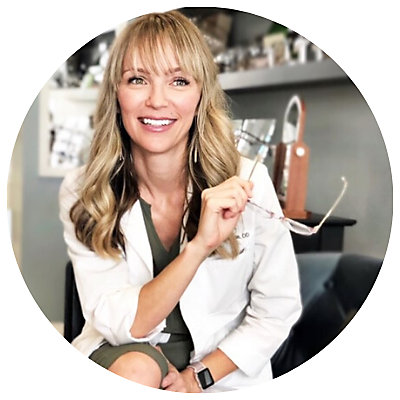Dr. Jen Wademan is a Graduate of Marshall B Ketchum College of Optometry. She practices comprehensive optometry integrating patient management of nutrition and eye health. Dr. Wademan received her undergraduate degree from University of California at Davis in biology with emphasis in neurology, physiology and behavior. She practices in Northern California, bouncing back and forth between running her private practice and raising her family. She is passionate about connecting with others and sharing tips on maintaining and prioritizing healthy eyes with a healthy lifestyle and habits.
As a healthcare professional, specifically within eyecare, my priority in caring for patients centers on protecting eye health and preventing eye disease. Outside of my patients’ daily immediate visual needs, including glasses and contacts, I consider the assessment of eye health for long-term visual needs highly important. These long-term needs encompass the myriad of eye health changes mostly related to age, but also lifestyle factors such as digital device use and blue light exposure.
Nutrition plays a key role in vision. It is easy to see the connection when we specifically examine lutein and zeaxanthin, two carotenoids that are essential components in eye health.
Most of us in the eyecare profession know very well the relation between lutein, zeaxanthin and eye health concerns like Age-Related Macular Degeneration (ARMD). ARMD affects 1.8 million Americans 40 years or older and it is the leading cause of vision loss in individuals 65 years and older. [1] The Age-Related Eye Disease Study 2 (AREDS2) provided a foundation for nutritional supplementation and protection of eye health. The study gave eyecare professionals specific guidance on reducing the risk of progression to advanced ARMD and, in turn, provided strong recommendations for eyecare professionals to communicate to their at-risk patients. [2]
Communicating the concerns over blue light exposure and its connection to eye health is a frequent conversation within clinical practice, now more than ever. With 60% of Americans using a digital device more than 5 hours per day and children using devices more than 3 hours per day, symptoms of eye fatigue, eye strain, headaches, blurred vision, and dry eyes are more common place in clinical practice.[3,4,5] Blue light emitted from artificial light and digital devices pose a risk to the long-term health of the eye by damaging the protective barrier (macular pigment) in the eye, which acts to naturally filter for harmful rays of blue light.[6,7] While completely eliminating blue light is not possible, discussing ways to protect vision long-term from overexposure to blue light is a course of action eyecare professionals can now include in patient care recommendations.
With that said, incorporating a discussion about lutein and zeaxanthin in a clinical practice setting can actually be an easy one. I find that patients are already asking questions on how to proactively protect their vision and sight.
My approach to answering these questions is to provide guidance for nutritional habits that allow for easily adaptable and attainable goals. No one wants a list of do’s and don’ts that cannot be accomplished. Broad recommendations to “eat more green leafy vegetables” is a good start but falls short in clinical practice. Patients ask, “How much?” and “What type?” Eyecare professionals need to follow up on this recommendation to understand if advice leads to a change in habits and increase in compliancy. In fact, most patients fail to meet the recommended intake of lutein and zeaxanthin, getting only 1-2 mg of lutein and zeaxanthin from foods.[8-10] When compared to the recommended 10 mg of lutein and 2 mg of zeaxanthin for optimal eye health protection, not only are changes to an individual’s diet necessary, but often supplementation is needed to fill in the gaps.
In my practice, I emphasize adding a supplement containing FloraGLO® Lutein and OPTISHARP® Natural Zeaxanthin, two ingredients shown to support eye health through-out life. [8] FloraGLO Lutein has over 90 human publications and was the lutein used in AREDS2. [2,12] Providing easily attainable dietary goals ensures patients can adapt their lifestyle and habits to include protection for eye health. A daily supplement with FloraGLO Lutein at 10 mg provides the equivalent of 3 cups of raw spinach daily!
For many health reasons, a diet that is rich in vegetables and fruits is still essential. FloraGLO Lutein and OPTISHARP Natural Zeaxanthin enrich the macula and are key nutrients that reduce the risk of progression to advanced ARMD and cataracts.[2,13,14] Lutein and zeaxanthin also are nutrients that help filter blue light, acting as a protective barrier. [15] Because the human body doesn’t naturally produce these nutrients, it’s important to add them by diet and supplementation [16]. It is easy to see why FloraGLO Lutein along with OPTISHARP Natural zeaxanthin provide benefits to guard against age-related vision problems through-out life, while accounting for blue light exposure in our digital era.

FloraGLO® is distributed by DSM Nutritional Products. OPTISHARP® Natural is a trademark of DSM.
References available upon request.
These statements have not been evaluated by the Food and Drug Administration. This product is not intended to diagnose, treat, cure or prevent any disease.
FloraGLO® Lutein for Eye Health
FloraGLO Lutein® for Brain Health

Protecting Eyes from Digital Device Use

The Control You've Been Craving

Five Factors that Affect the Immune System

The Mind-Body Connection
